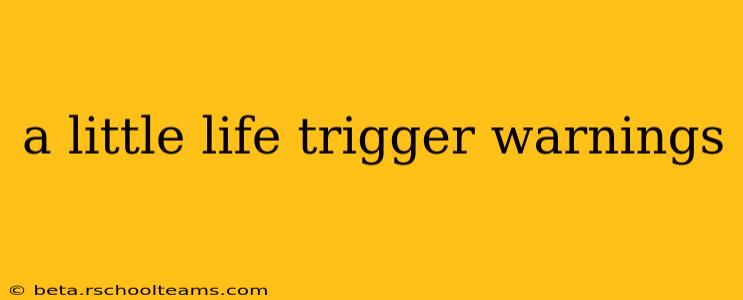A Little Life: Trigger Warnings and Content Considerations
Hanya Yanagihara's A Little Life is a powerful and moving novel, but its exploration of profound trauma necessitates a serious discussion about its trigger warnings. The book deals with extremely sensitive subject matter that may be deeply upsetting for some readers. It's crucial to approach this book with awareness and self-care in mind.
What are the main trigger warnings for A Little Life?
The novel contains graphic depictions of:
- Severe childhood sexual abuse: This is a central theme throughout the narrative and is depicted in significant detail. The abuse is not glossed over and its long-term effects are explored extensively.
- Self-harm and suicide attempts: Jude, the main character, struggles with self-destructive behaviors stemming from his past trauma. These are described vividly and in a realistic manner.
- Physical and emotional abuse: Beyond the childhood sexual abuse, Jude experiences various forms of physical and emotional abuse throughout his life, further contributing to his psychological struggles.
- Addiction: The novel touches upon substance abuse as a coping mechanism for trauma.
- Graphic depictions of violence: While not always directly inflicted upon Jude, the novel depicts acts of violence that can be disturbing to readers.
- Mental health issues: The book portrays the complex and challenging realities of living with trauma, including PTSD, depression, and anxiety.
Why is it important to discuss trigger warnings?
Trigger warnings are not about censorship; they are about responsible content consumption. They allow potential readers to make an informed decision about whether or not they are prepared to engage with material that might be harmful to their mental and emotional well-being. For someone who has experienced similar traumas, reading detailed descriptions might be retraumatizing.
How can readers prepare themselves?
- Read reviews and discussions: Gain a better understanding of the book's content before starting. Pay attention to what other readers have said about the graphic nature of certain scenes.
- Read in manageable chunks: Don't feel pressured to read the entire book in one sitting. Take breaks when needed.
- Have a support system: Discuss your reading experience with a friend, family member, therapist, or support group. Sharing your feelings can be incredibly helpful.
- Know your limits: If you find yourself becoming overwhelmed or distressed, stop reading. Your well-being is paramount.
- Seek professional help if needed: If the book triggers intense emotional distress, consider seeking professional help from a therapist or counselor.
Beyond the Trigger Warnings: The Importance of the Book's Themes
Despite the challenging content, A Little Life is a powerful exploration of resilience, friendship, and healing. The book's unflinching portrayal of trauma is intended to raise awareness and foster empathy, not to exploit suffering. While the content is undeniably difficult, its importance in sparking conversation and understanding should not be overlooked.
In conclusion, A Little Life is a significant work of literature that tackles complex and challenging themes. It is imperative that potential readers are aware of the trigger warnings and approach the book with careful consideration for their own mental and emotional well-being. Remember that seeking support and prioritizing your mental health is always a sign of strength, not weakness.
